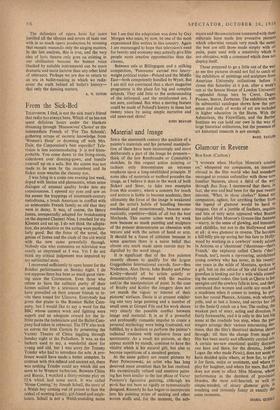Material and Image
SINCE the nineteenth century the qualities of a painter's materials and his personal manipula- tion of them have been increasingly and more deliberately a part of the image he presents— think of the late Rembrandts or Constable's sketches. In this respect action painting or tachism only demonstrates an extreme emphasis upon a long-established principle. If some idea of materials or method precedes the image, as I believe it does in the work of both Sickert and Steer, to take two examples from this country, where a concern for touch and texture is liable to become academic, then ultimately the force of the image is weakened and the artist's habits of handling become mechanical and monotonously, because auto- matically, repetitive—think of all but the best Morlands. This matter arises week by week now because so much painting and sculpture of the present demonstrates an obsession with texture and with the action of hand or arm. It should be a focus of criticism because in some quarters there is a naive belief that almost any mark made upon canvas may be dignified by the word image.
It is significant that of the five painters recently chosen to qualify for the largest Guggenheim International awards, four—Ben Nicholson, Alan Davie, John Bratby and Peter Kinley—should all be artists quietly or demonstratively obsessed with the math re and/or the manipulation of paint. In the case of Bratby and Kinley the imagery does not yet match the vigour or interest of their pictures' surfaces. Davie is at present exhibit- ing one very large painting and a number of small ones at Gimpel Fits and his work shows very clearly the possible conflict between image and material. It is as if a powerful and profoundly romantic impulse to create a personal mythology were being frustrated, not fulfilled, by a decision to perform the painter's technical routines with explosive force and spontaneity. As a result his pictures, as they appear month by month, continue to have the vitality which is his natural gift, but also to become repetitions of a standard gesture.
At the same gallery are recent pictures by Peter Potworowski, an artist who has long deserved more attention than he has received. His exceptionally refined and sensitive paint- ing has been similar to the last phase of Victor Pasmorc's figurative painting, although his work has not been so rigidly or systematically designed. Recently he has begun to incorporate into his painting strips of sacking and other woven stuffs and, for the moment, the sub-
stance and the associations connected with then materials have made less evocative picture which otherwise remain very much the same the best arc still those made simply with of paint, paint used with a sensitivity which I not obtrusive, with a command which does no display itself.
Those prepared to go a little out of the wa! to See fine pictures should not fail to catch t11 the exhibition of paintings and sculpture fro''' American University collections before . closes this Saturday at 6 p.m. after a week' run at the Senate House of London Universit! —splendid things here by Corot, Degas Picasso, Seurat, Zurbaran. The exhibition wit! its substantial catalogue shows how the pre sence and study of works of art are include( in higher education in the States. With thl Ashmolean, the Fitzwilliam, and the Barbel Institute we can hold our own in the way ol large historical collections, but the presence of art historical research is not enough.
BASIL TAYLOt










































 Previous page
Previous page